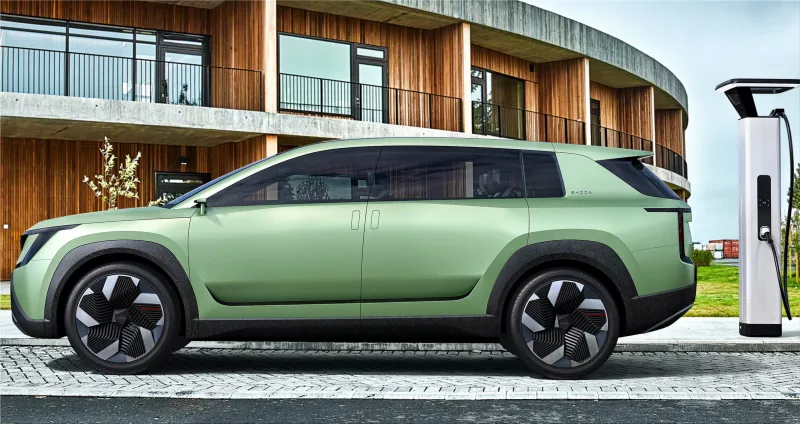The new Skoda Vision 7S prototype is the company's first particular preview of a new model. At the same time, it helps to define the brand's new design language. The Skoda Vision 7S electric SUV has space for seven people. The concept is built on Volkswagen Group's Modular Electrification Kit (MEB) platform and has an 89 kWh battery. The battery provides a maximum range of 600km.
As previously said, this model has produced a new aesthetic language for the electric and digital eras, which will be phased in next year. We find sleek lines that emphasize the new models' simplicity and value. The new front, called Tech-Deck Face, and interiors created from sustainable materials are distinguishing features of the new design language.
3D graphics will no longer be used in the new brand logo. This is Skoda's response to the rising movement in marketing activity from print to online. Corporate Identity (CI) has also changed a lot. Skoda will use two different shades of green—Emerald and Verde Elettrico—to show that it cares about the environment, wants to be sustainable, and wants to make electric cars.
The Skoda lettering will be more prominent in marketing communication activities than the business emblem. The new style employs a new font based on symmetry and combines rounded forms and firm edges. The most challenging aspect is incorporating the diacritical mark above the S, which is a significant part of the SKODA tradition. The so-called hacek has now been incorporated into the initial letter. According to studies, typographic lettering is easier to distinguish and identify.

The winged arrow emblem has also been altered, though not as dramatically as the writing. At first sight, the reduced design is evident. The redesigned logo now appears without any three-dimensional effects. The Bohemian vehicle maker responds to the move towards increasingly more electronic communication. The simpler, two-dimensional image is more effective, especially on mobile devices, and it is easier to add to other formats.
The new CI will gradually expand throughout all platforms, initially in information and communication materials, beginning in 2024, on the models already described. The new look will also appear in Skoda cars' infotainment systems and other features.
The Skoda Vision 7S is the first vehicle to feature the Czech automaker's eye-catching new design language. It has a particularly muscular lower body and aerodynamic roof lines that boost its efficiency and the Tech-Deck Face front. At first glance, the lengthy passenger compartment suggests a spacious cabin.
The vehicle's front end also features recognizable design characteristics, such as the distinctive hood line. Skoda lettering has been modified to replace the brand's front logo, and it is supplemented by a new strip of ambient lighting. This spans the entire car width at the front part's top border and is lit. The so-called Tech-Deck Face is a fresh take on the iconic Skoda grille. Despite having identical lines, the Tech-Deck Face is much flatter and broader than the preceding model. Opaque glass has replaced the ribs, which conceals the vehicle's sensors.
The narrow headlights are placed further out and stacked in two rows, one above the other, forming a T with the four-light headlight assembly. The daytime running lights extend to the fenders, forming a sharply defined upper line of the "T" that optically frames the front. The LED rear lights are likewise positioned similarly. The top line extends laterally into the wheel arches once more. This pattern is repeated on both the side cameras acting as rearview mirrors, and the door handles activated by sensors.
The front and rear bumpers are constructed of durable materials derived from recycled tires. This material is also utilized for wheel arch linings, giving them a more substantial appearance. Air is delivered to the cooling systems and brakes via seven vertical air intakes incorporated into the front. In the rear bumper of the Vision 7S, there are nine vertical vents for air to travel through. A bright orange control element is located in the front and back center. These elements can be drawn out to serve as hooks.
The high tornado line divides the large lower body from the side window region through its curvature and highlights the muscular shoulder parts. The wheel arches are both prominent and recessed. The wheels are 22 inches in diameter, and the aerodynamically designed rims are almost entirely closed.

Additional air vents are between the wheel arches and above the side skirts. These function as footboards for doors that open in opposite directions and have cover grilles. These grids transport the hot air produced by cooling the high-voltage battery outside. The flat roof line descends gently to the back for maximum aerodynamic efficiency and is combined with a noticeable roof spoiler. The triangular C-pillar stands out with its striking design. The new Skoda lettering appears at the bottom and is lighted, as well as on the tailgate and at the front of the vehicle.
The simple interior is roomy and gives the impression of security. Natural leather was not used for the interiors but rather materials from sustainable sources that are exceptionally robust due to some combinations. Another example is the bottom, which is also built from recycled tires. The interior moldings are also environmentally friendly, as they are covered with a thin matte metallic layer, and the fabrics are manufactured from 100% recycled polyester yarns. A strong emphasis has been placed on improving the usability of all commands.
The Skoda Vision 7S has two cabin configurations, with a rotating central touchscreen and sliding pieces to create the ideal environment for different situations: driving and relaxing. All controls are conveniently located within easy reach of the driver while driving, and the primary 14.6-inch touchscreen is positioned vertically to increase accessibility and information overlap. Relax mode can be activated while charging or parked by pressing a button on the center console. The passenger compartment morphs with an elegant synchronized movement: the steering wheel and instrument panel glide backward from the driver and passengers to make more room. For enhanced comfort, the front row seats tilt inward and recline, letting back passengers see the screen.
The steering wheel has been overhauled, with two large spokes at the 12 and 6 o'clock positions. The new steering wheel is placed in the center of the steering wheel, and the crown is flattened at the top and bottom to make the car's 8.8-inch digital display visible. There are separate scroll wheels for the most crucial functions when driving, which are highlighted by bright orange inserts for rapid orientation. In Relax mode, the driver can use the touchpad embedded in the lower ramp to activate more advanced functions.
The enormous 14.6-inch rotatable screen, the largest ever placed in a Skoda vehicle, dominates the dashboard's center. The display is oriented vertically in Drive mode, allowing for excellent superimposition of information; for example, the upper section of the screen is dedicated to critical visual elements such as the map and navigation directions, while the lower area is easy to access and manage. Swiping up or down adjusts the quantity of information displayed to the user. Furthermore, the menu widget can be utilized to go through numerous functions. User-installed apps can be used to watch movies or play games in leisure mode, especially when the screen is angled horizontally. Because the screen is further away when the seats are reclined, the infotainment system can also be controlled via a smartphone.
The revamped center console includes six new buttons that provide immediate access to the infotainment, phone, car settings, navigation, and app menus for the driver; the sixth button can be allocated to the user. Below are three massive rotary controls: the two outside dials adjust climate, while the center dial controls screen content. It allows you to zoom in and out of the map and navigate between listings. Below are two buttons for switching from drive to relax mode and a wheel for scrolling the volume. The buttons and dials, like the steering wheel controls, have bright orange highlights for convenience of use.
For best viewing, second and third-row passengers can magnetically connect their gadgets to the seat backrests. Interactive surfaces with colored lights that shine through the fabric are integrated into the door panels; for example, a bright, bright orange light indicates the opening handles hidden at the bottom of the panel, whereas a blue or red light displays the temperature variations of the air conditioning. It is also possible to write on the cloth with your finger, make short notes, or let youngsters sketch it.
The location of the child seat is also novel, as it is located in the most secure area of the car. It is built into the center console, which extends to the second row of seats in the opposite direction of travel. In this manner, the child is well protected, and passengers in the second row can always keep an eye on him. A video of the youngster can also be transmitted to the central infotainment display via an optional indoor camera situated in the rear of the rear pavilion. In this manner, the driver and front passenger can always see the children on board.
The Skoda Vision 7S's huge panoramic glass roof floods the inside with light. A giant crystal above the primary screen reveals the state of charge of the vehicle's battery through various luminous signs. This is also plainly seen from the outside of the car.



